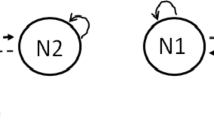Abstract
We propose a network model with dissipative structure taking into consideration the effect of neighboring activation and individual dissipation. Nodes may feel tired of interactions with new nodes step by step, and drop out of the network evolution. However, these dormant nodes can become active again following neighbors. During the whole evolution only active nodes have opportunities to receive new links. We analyze user behavior of a real Internet forum, and the statistical characteristics of this forum are analogous to our model. Under the influence of motivation and dissipation, the degree distribution of our network model decays as a power law with a diversity of tunable power exponents. Furthermore, the network has high clustering, small average path length and positive assortativity coefficients.
Similar content being viewed by others
References
R. Albert, A.L. Barabasi, Rev. Mod. Phys. 74, 47 (2002)
Y. Kim, Y. Ko, S.H. Yook, Phys. Rev. E 81, 011139 (2010)
J. Camacho, R. Guimera R, L.A.N. Amaral, Phys. Rev. Lett. 88, 228102 (2002)
S.N. Dorogovtsev, J.F. Mendes, Phys. Rev. E 63, 056125 (2001)
W. Li, X. Cai, Phys. Rev. E 69, 046106 (2004)
G. Yan, Z.Q. Fu, J. Ren, W.X. Wang, Phys. Rev. E 75, 016108 (2007)
L.A. Adamic et al., Science 287, 2115 (2000)
R. Pastor-Satorras, A. Vazquez, A. Vespignani, Phys. Rev. Lett. 87, 258701 (2001)
H. Dietz, M. Rief, Phys. Rev. Lett. 100, 098101 (2008)
M.E.J. Newman, Phys. Rev. E 64, 016132 (2001)
M.E.J. Newman, Proc. Natl. Acad. Sci. 98, 404 (2001)
D.J. Watts, S.H. Strogatz, Nature 393, 440 (1998)
M.E. Newman, D.J. Watts, Phys. Lett. A 263, 341 (1999)
A.L. Barabasi, R. Albert, Science 286, 509 (1999)
R. Albert, A.L. Barabasi, Phys. Rev. Lett. 85, 5234 (2000)
Z.X. Huang, X.R. Wang, H. Zhu, Chinese Phys. B 13, 273 (2004)
W.X. Wang, B.H. Wang, B. Hu, G. Yan, Q. Ou, Phys. Rev. Lett. 94, 188702 (2005)
A. Santiago, R.M. Benito, Eur. Phys. J. B 76, 557 (2010)
Q. Guo et al., Physica A 371, 814 (2006)
X.P. Xu, F. Liu, W. Li, Chinese Phys. Lett. 23, 750 (2006)
C.S. Rodrigues, A.P.S. Moura, C. Grebogi, Phys. Rev. E 80, 026205 (2009)
E. Bertin, O. Dauchot, Phys. Rev. Lett. 102, 160601 (2009)
S.N. Dorogovtsev, J.F.F. Mendes, Phys. Rev. E 62, 1842 (2000)
K. Klemm, V.M. Eguiluz, Phys. Rev. E 65, 036123 (2002)
M.E.J. Newman, Phys. Rev. Lett. 89, 208701 (2002)
F. Wang, Y. Moreno, Y. Sun, Phys. Rev. E 73, 036123 (2006)
F. Fu, L.H. Liu, L. Wang, Physica A 387, 675 (2008)
K.I. EGoh et al., Phys. Rev. E 73, 066123 (2006)
Author information
Authors and Affiliations
Corresponding author
Rights and permissions
About this article
Cite this article
Xiong, F., Liu, Y., Zhu, J. et al. A dissipative network model with neighboring activation. Eur. Phys. J. B 84, 115–120 (2011). https://doi.org/10.1140/epjb/e2011-20286-7
Received:
Revised:
Published:
Issue Date:
DOI: https://doi.org/10.1140/epjb/e2011-20286-7




